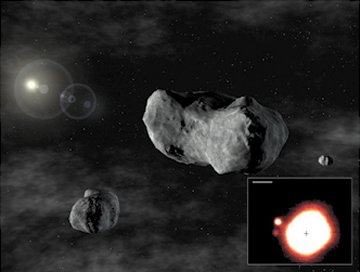Among the thousands of asteroids roaming the inner solar system, 87 Sylvia stands out. New observations reveal that two smaller asteroids orbit this 280-kilometer-wide rock. It’s the first asteroid found to be accompanied by two moons.

More than just a curiosity, the tiny moons have enabled researchers to determine the mass and density of 87 Sylvia. Like some other asteroids, the rock turns out to be extraordinarily porous, with up to 60 percent of its interior composed of empty space, report Franck Marchis of the University of California, Berkeley and his colleagues in the Aug. 11 Nature. This suggests that 87 Sylvia formed when two much larger asteroids smacked into each other and broke apart.
Most of the fragments from the proposed breakup reassembled into a loose agglomeration held together only weakly by gravity. Planetary scientists call such a fragile coalescence a rubble pile (SN: 7/28/01, p. 61: A Rocky Bicentennial). The two moons are probably leftover debris from the same collision that produced 87 Sylvia, Marchis’ team suggests. The astronomers also described their findings this week at the Asteroid Comet Meteor conference in Armação dos Búzios, Brazil.
Marchis and his colleagues became interested in 87 Sylvia, one of the largest rocks in the asteroid belt between Mars and Jupiter, after another team announced in 2001 that it had discovered a single moon circling the asteroid. That moon measures about 18 km across and orbits 1,360 km from 87 Sylvia.
Scientists know of 60 or so moon-bearing asteroids. The most likely scenario for their formation—the collision of larger asteroids—suggests that at least some of them should have additional moonlike fragments circling them.
Marchis and his collaborators found a second, smaller moon by sifting through 2 months of images of 87 Sylvia. The team used an infrared camera on the European Southern Observatory’s Very Large Telescope in Paranal, Chile. The small moon, about 7 km in diameter, circles 710 km from 87 Sylvia.
The orbits of both moons, along with the size of 87 Sylvia, reveal that the large asteroid has an average density less than half that of solid rock, the team calculates.
“The rubble-pile [model] is the best explanation” for the formation of 87 Sylvia, comments Joseph Veverka of Cornell University. While many other of the belt’s asteroids also qualify as rubble piles, other denizens of the belt, such as the large, moonless asteroids Ceres, Pallas, and Vesta, are more solid, he adds.
Discovered in 1866, 87 Sylvia is named after Rhea Sylvia, the mythical mother of the founders of Rome. Inspired by that moniker, Marchis and his colleagues recently proposed that the two moons be called Romulus and Remus after the city’s imaginary founders. Remus is the newly discovered moon that orbits closest to the asteroid. At press time, the International Astronomical Union was expected to formally approve those names by week’s end.







